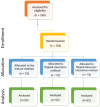Knowledge acquisition and student perceptions of three teaching methods: a randomized trial of live, flipped, and interactive flipped classrooms
- PMID: 40251621
- PMCID: PMC12008932
- DOI: 10.1186/s12909-025-07156-0
Knowledge acquisition and student perceptions of three teaching methods: a randomized trial of live, flipped, and interactive flipped classrooms
Abstract
Background: Traditional lecture-based learning has been the cornerstone of dental education; however, active learning strategies such as flipped classrooms are gaining popularity for their potential to enhance student engagement and performance. This study evaluated the effectiveness of three teaching methods-traditional live lectures, flipped video classrooms, and interactive flipped classrooms-on improving academic performance and student perceptions among fourth-year dental students.
Methods: This study employed a stratified randomization design involving 156 fourth-year dental students using a single lecture in an undergraduate orthodontics course. The students were first grouped into four categories based on their Grade Point Average (GPA): Excellent, Very Good, Good, and Satisfactory. From these groups, students were randomly drawn and placed into one of three intervention groups: live lecture, flipped classroom with video lectures, and flipped classroom with interactive video lectures. Pre- and post-intervention assessments evaluated knowledge improvement, while objective structured assessments measured academic performance. Student perceptions were gauged using validated Likert-scale questionnaires. Paired t-tests assessed within-group differences, and ANOVA compared effectiveness across teaching methods. Pearson's correlation analysis examined the relationship between academic performance and GPA of the students.
Results: All three teaching methods showed significant improvements in post-intervention scores (p < 0.001). The Live Lecture Group had the greatest mean improvement (27.69), followed by the Flipped Video Lecture Group (27.30) and the Flipped Interactive Lecture Group (27.11). However, ANOVA revealed no statistically significant differences between the groups (F (2, 153) = 0.007, p = 0.993). Female students performed better in the live lecture setting (32.60 ± 25.08) compared to males (23.79 ± 21.44). Students with lower GPAs benefited most from the interactive flipped classroom, Pearson's correlation indicated a strong positive association between GPA and post-intervention scores (r = 0.708, p < 0.001). Student satisfaction was highest in the interactive flipped classroom, with 97.7% rating the experience as "Excellent" or "Very Good."
Conclusions: All three teaching methods led to significant improvement in post-test scores. While students reported higher engagement and satisfaction in flipped and interactive flipped lectures, the live lecture method was also effective for knowledge retention. These findings highlight the importance of tailoring educational strategies to diverse student needs in dental education. Educators should consider a blended model that integrates flipped and traditional strategies selectively, balancing feasibility with student needs, as developing multiple formats can be time-intensive with only modest differences in outcomes.
Clinical trial number: Not applicable.
Keywords: Dental education; Flipped classroom; Student performance; Student satisfaction; Teaching methods.
© 2025. The Author(s).
Conflict of interest statement
Declarations. Ethics approval and consent to participate: The study was conducted in accordance with the guidelines of the Declaration of Helsinki and approved by the Institutional Review Board (IRB) of Ajman University (protocol code D-F-H-18-Oct and date of approval: November 8, 2022). Informed consent was obtained from all participants involved in the study. Consent for publication: Not applicable. Competing interests: The authors declare no competing interests.
Figures



Similar articles
-
Assessing the effectiveness of flipped classroom teaching-learning method among undergraduate medical students at gondar university, college of medicine and health sciences: an interventional study.BMC Med Educ. 2024 Oct 7;24(1):1108. doi: 10.1186/s12909-024-06105-7. BMC Med Educ. 2024. PMID: 39375705 Free PMC article.
-
Effectiveness of and Dental Student Satisfaction with Three Teaching Methods for Behavior Guidance Techniques in Pediatric Dentistry.J Dent Educ. 2019 Aug;83(8):966-972. doi: 10.21815/JDE.019.091. Epub 2019 May 13. J Dent Educ. 2019. PMID: 31085686
-
The effects of flipped classrooms to improve learning outcomes in undergraduate health professional education: A systematic review.Campbell Syst Rev. 2023 Jul 7;19(3):e1339. doi: 10.1002/cl2.1339. eCollection 2023 Sep. Campbell Syst Rev. 2023. PMID: 37425620 Free PMC article. Review.
-
Application of the flipped classroom model based on Bloom's Taxonomy of Educational Objectives in endodontics education for undergraduate dental students.PeerJ. 2025 Jan 29;13:e18843. doi: 10.7717/peerj.18843. eCollection 2025. PeerJ. 2025. PMID: 39897504 Free PMC article.
-
Flipped classrooms in pharmacy education: A systematic review.Saudi Pharm J. 2023 Dec;31(12):101873. doi: 10.1016/j.jsps.2023.101873. Epub 2023 Nov 13. Saudi Pharm J. 2023. PMID: 38033750 Free PMC article. Review.
References
-
- Park SE, Howell TH. Implementation of a flipped classroom educational model in a predoctoral dental course. J Dent Educ. 2015;79(5):563–70. - PubMed
-
- Sawarynski KE, Eastwood JL, Iyer N, An, Integrated, Flipped Classroom Model for Medical Education. FASEB J. 2013 Apr [cited 2024 Aug 24];27(S1). Available from: https://faseb.onlinelibrary.wiley.com/doi/10.1096/fasebj.27.1_supplement.517.1
-
- South Asian Institute of Technology and Medicine (SAITM), Malabe S, Lanka, Perera V, De Silva N. Flipped classroom model for teaching and learning medical microbiology. TAPS. 2017;2(2):24–9.
-
- Chutinan S, Riedy CA, Park SE. Student performance in a flipped classroom dental anatomy course. Eur. J. Dent. Educ. 2018 Aug [cited 2024 Aug 24];22(3). Available from: https://onlinelibrary.wiley.com/doi/10.1111/eje.12300 - PubMed
Publication types
MeSH terms
LinkOut - more resources
Full Text Sources
Medical

